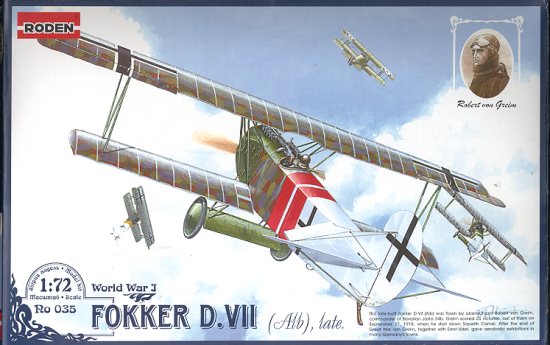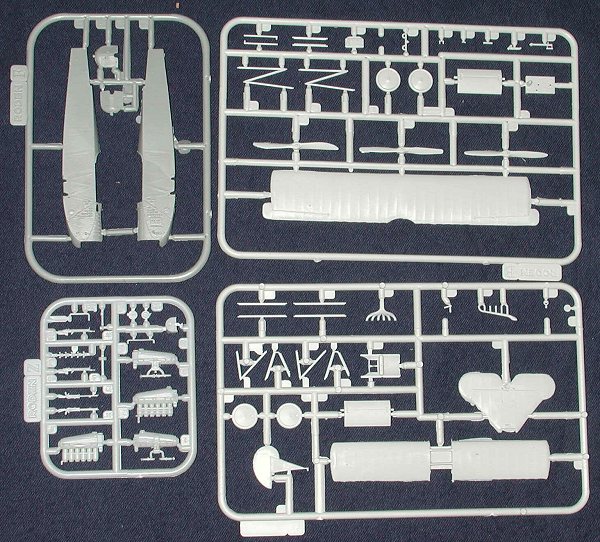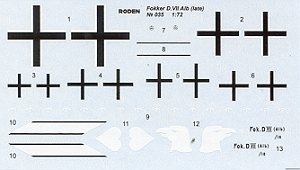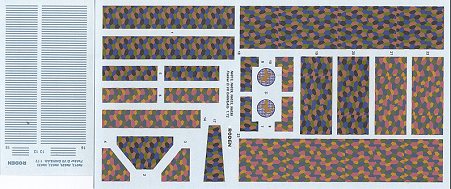
|
KIT: |
Roden 1/72 Fokker D.VII (Alb) late |
|
KIT # |
035 |
|
PRICE: |
$9.98 MSRP |
|
DECALS: |
5 options |
|
REVIEWER: |
|
|
NOTES: |

|
HISTORY |
Once again, Roden saves my butt by providing this historical background!
|
THE KIT |

Roden has gained a loyal following by producing WWI subjects over the last few years. Much of this is due to the depth in which they have researched the subject and their willingness to ensure as much accuracy as possible. When you look at this kit and compare it to the much simpler Revell offering of the late 1960s, you can see that there has been a quantum jump in detail. As is so much the norm with modern kits, a multiplicity of variables have catered to with this kit's molding. The real difference when it comes to the D.VII variants (and correct me if I'm wrong) is the forward fuselage of the aircraft. It is here that the different engines, radiators and engine side panels show the correct variant and/or manufacturer. Instead of offering separate noses, Roden just chose to mold the appropriate fuselage halves that includes the correct radiator.
You'll have to excuse me in regards to the image as I used one from a different
kit to show the various bits, but the only difference is the fuselage sprue. It
has the correct multiple-louvered engine cover panels that were a trademark of
late Albatros builds. The parts themselves are typical of Roden kits in that
they are of relatively soft plastic and have some flash and in some instances a
slight sink or surface glitch. This is mostly due to the heavy use of the molds
and the majority of the  sprues are
used in multiple kits. In fact, you will have quite a number of parts that you
don't use. Just looking at the sprues you can see that there are two engines,
two exhaust stacks, two sets of wheels/axles, and three different props. The
modeler also has to modify the fuselage halves by removing some plastic around
the engine to properly portray some of the aircraft in this kit.
sprues are
used in multiple kits. In fact, you will have quite a number of parts that you
don't use. Just looking at the sprues you can see that there are two engines,
two exhaust stacks, two sets of wheels/axles, and three different props. The
modeler also has to modify the fuselage halves by removing some plastic around
the engine to properly portray some of the aircraft in this kit.
The instructions are excellent, showing any modifications needed and specifying
which parts will go with which versions. There are five decal options; three
from Jasta 34 and two from Jasta 40. The Jasta 34 planes include the box art
aircraft with the forward fuselage in green and the aft in light grey. The
individual planes also have colored strip es
around the fuselage which the builder needs to paint. From Jasta 40 are two
planes with black forward fuselages and white tails. These both have white
pilot's markings on the side. You can also see that there is a huge sheet of
nothing but upper and lower camouflage and rib tape stripes. There has
been much discussion as to the color of this lozenge camo, and I don't know
enough to make an opinion, but it looks about right to me. It is really quite
nice of Roden to include this large sheet as it cuts down on the cost of hunting
up an aftermarket sheet. Since basically the wings are in this lozenze and in
some cases the fuselage or at least part of it is in this material, it means
that you won't have to do that much painting. I can see where decal application
will take on a much larger percentage of the build time!
es
around the fuselage which the builder needs to paint. From Jasta 40 are two
planes with black forward fuselages and white tails. These both have white
pilot's markings on the side. You can also see that there is a huge sheet of
nothing but upper and lower camouflage and rib tape stripes. There has
been much discussion as to the color of this lozenge camo, and I don't know
enough to make an opinion, but it looks about right to me. It is really quite
nice of Roden to include this large sheet as it cuts down on the cost of hunting
up an aftermarket sheet. Since basically the wings are in this lozenze and in
some cases the fuselage or at least part of it is in this material, it means
that you won't have to do that much painting. I can see where decal application
will take on a much larger percentage of the build time!
|
CONCLUSIONS |
So there you have it. Another entry into the WWI ranks and one that I'm sure is finding favor with a lot of modelers.
Thanks to the fine folks at
 for the review kit. Visit
them by clicking on the logo.
for the review kit. Visit
them by clicking on the logo.
If you would like your product reviewed fairly and fairly quickly by a site that has well over 175,000 visitors a month, please contact me or see other details in the Note to Contributors.